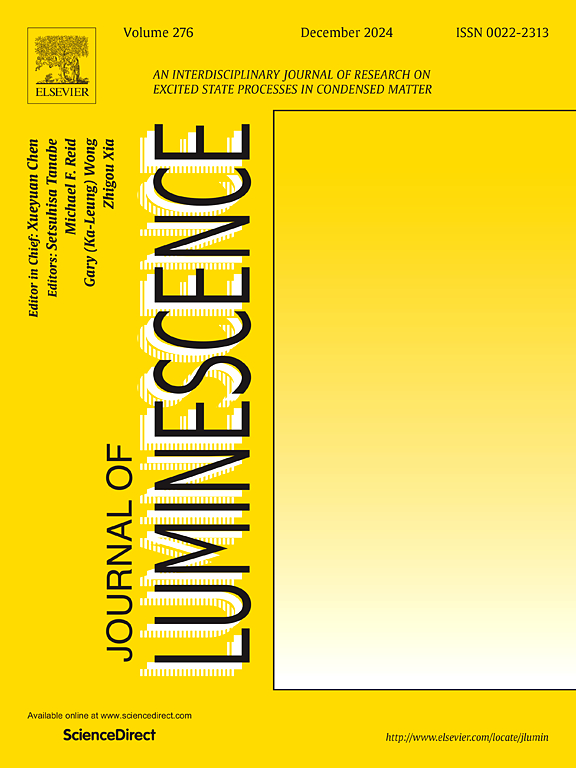Time-resolved luminescent biodetection of biotin in infant formula based on lanthanide-doped LiLuF4 nanoparticles
IF 3.3
3区 物理与天体物理
Q2 OPTICS
引用次数: 0
Abstract
Biotin, as a key nutrition fortifier in infant formula, is of vital significance for guaranteeing the healthy growth of infants and young children. The accurate detection of biotin has therefore become a crucial priority for quality assurance in infant formula. However, the current bioassay techniques encounter a series of limitations such as cumbersome procedures and low sensitivity. Herein, we develop a sensitive time-resolved fluorescence resonance energy transfer (TR-FRET) nanoprobe by employing LiLuF4: Ce/Tb nanoparticles (NPs) as energy donors for biotin detection. By taking advantage of the distinctive millisecond-range photoluminescence of the NPs, the short-lived background autofluorescence can be completely eliminated, which enables the sensitive detection of biotin in infant formula within a range of 0–6104 pM and a detection limit down to 0.84 pM (0.21 pg mL−1). This value indicates 2−4 orders of magnitude improvement over conventional bioassay methods. The proposed TR-FRET biosensor is independent of expensive instruments and can be fully compatible with commercial microplate readers. Specifically, the homogeneous assay design enables rapid, user-friendly analysis, completing the entire detection process within 20 min. These findings offer new opportunities towards rapid and sensitive detection of biotin in infant nutrition products, thereby demonstrating the great potential of lanthanide nanoprobes in food safety monitoring applications.
基于镧系掺杂LiLuF4纳米粒子的婴儿配方奶粉中生物素的时间分辨发光生物检测
生物素作为婴幼儿配方奶粉中重要的营养强化剂,对保证婴幼儿健康成长具有重要意义。因此,生物素的准确检测已成为婴儿配方奶粉质量保证的关键优先事项。然而,目前的生物测定技术遇到了一系列的限制,如繁琐的程序和低灵敏度。在此,我们开发了一种灵敏的时间分辨荧光共振能量转移(TR-FRET)纳米探针,采用LiLuF4: Ce/Tb纳米粒子(NPs)作为生物素检测的能量供体。利用NPs独特的毫秒范围的光致发光,可以完全消除短暂的背景自身荧光,从而能够在0-6104 pM范围内灵敏地检测婴儿配方奶粉中的生物素,检测限低至0.84 pM (0.21 pg mL−1)。该值表明比传统的生物测定方法提高了2 - 4个数量级。提出的TR-FRET生物传感器是独立于昂贵的仪器,可以完全兼容商业微孔板读取器。具体来说,均相分析设计能够实现快速、用户友好的分析,在20分钟内完成整个检测过程。这些发现为快速、灵敏地检测婴儿营养产品中的生物素提供了新的机会,从而展示了镧系纳米探针在食品安全监测应用中的巨大潜力。
本文章由计算机程序翻译,如有差异,请以英文原文为准。
求助全文
约1分钟内获得全文
求助全文
来源期刊

Journal of Luminescence
物理-光学
CiteScore
6.70
自引率
13.90%
发文量
850
审稿时长
3.8 months
期刊介绍:
The purpose of the Journal of Luminescence is to provide a means of communication between scientists in different disciplines who share a common interest in the electronic excited states of molecular, ionic and covalent systems, whether crystalline, amorphous, or liquid.
We invite original papers and reviews on such subjects as: exciton and polariton dynamics, dynamics of localized excited states, energy and charge transport in ordered and disordered systems, radiative and non-radiative recombination, relaxation processes, vibronic interactions in electronic excited states, photochemistry in condensed systems, excited state resonance, double resonance, spin dynamics, selective excitation spectroscopy, hole burning, coherent processes in excited states, (e.g. coherent optical transients, photon echoes, transient gratings), multiphoton processes, optical bistability, photochromism, and new techniques for the study of excited states. This list is not intended to be exhaustive. Papers in the traditional areas of optical spectroscopy (absorption, MCD, luminescence, Raman scattering) are welcome. Papers on applications (phosphors, scintillators, electro- and cathodo-luminescence, radiography, bioimaging, solar energy, energy conversion, etc.) are also welcome if they present results of scientific, rather than only technological interest. However, papers containing purely theoretical results, not related to phenomena in the excited states, as well as papers using luminescence spectroscopy to perform routine analytical chemistry or biochemistry procedures, are outside the scope of the journal. Some exceptions will be possible at the discretion of the editors.
 求助内容:
求助内容: 应助结果提醒方式:
应助结果提醒方式:


